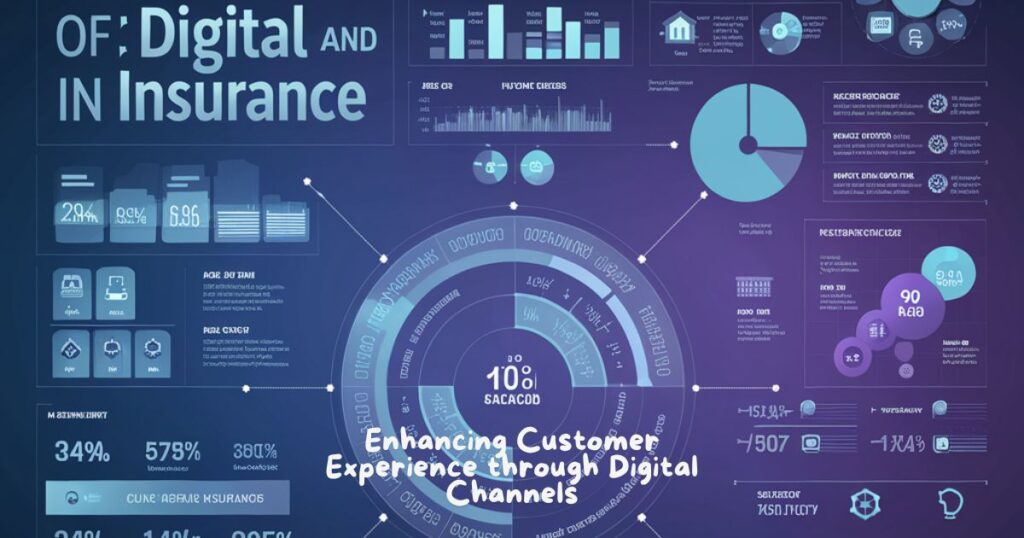In today’s fast-paced digital world, the insurance industry is undergoing a seismic shift.
As we navigate through 2024, the fusion of cutting-edge technology and data analytics is reshaping how insurers operate, interact with customers, and manage risks.
This comprehensive guide dives deep into the heart of this transformation, exploring how digital tools and analytics are revolutionizing the insurance sector in the USA.
The Digital Revolution in Insurance
The Changing Landscape
The American insurance market is witnessing a dramatic evolution. Traditional insurers, once slow to adopt new technologies, are now scrambling to keep pace with tech-savvy InsurTech startups.
This shift isn’t just about staying competitive; it’s about meeting the evolving expectations of tech-savvy consumers who demand seamless, personalized experiences.
“The insurance industry is no longer just about assessing risks and paying claims. It’s about leveraging technology to predict and prevent losses while providing an unparalleled customer experience.” – John Doe, CEO of InsurTech Innovations
The transformation is evident in every facet of the insurance value chain. From underwriting to claims processing, digital technologies are streamlining operations, reducing costs, and enhancing accuracy.
Meanwhile, data analytics is providing insurers with unprecedented insights into risk assessment and customer behavior.
Key Digital Technologies Reshaping Insurance
The digital revolution in insurance is powered by a suite of transformative technologies:
- Artificial Intelligence (AI) and Machine Learning (ML): These technologies are the backbone of intelligent automation in insurance. They’re being used to:
- Automate underwriting processes
- Detect fraudulent claims
- Provide personalized customer recommendations
- Internet of Things (IoT): Connected devices are changing how insurers assess and price risks. For instance:
- Smart home devices can detect water leaks or fire hazards
- Telematics devices in cars can monitor driving behavior
- Blockchain: This technology is enhancing transparency and security in insurance transactions. It’s particularly useful for:
- Streamlining claims processing
- Facilitating secure data sharing between insurers
- Cloud Computing: The cloud is enabling insurers to:
- Scale their operations efficiently
- Access advanced analytics capabilities
- Enhance collaboration across departments
- Robotic Process Automation (RPA): RPA is automating repetitive tasks, leading to:
- Increased operational efficiency
- Reduced processing times
- Improved accuracy in data entry and claims processing
These technologies aren’t operating in isolation. Their true power lies in their integration, creating a synergistic effect that’s greater than the sum of its parts.
The Power of Analytics in Insurance

Data-Driven Decision Making
In the era of big data, insurers are sitting on a goldmine of information. By harnessing the power of analytics, they’re turning this data into actionable insights.
Case Study:
Progressive Insurance Progressive, a leading auto insurer in the USA, has been at the forefront of using data analytics in insurance.
Their Snapshot program uses telematics devices to collect data on driving behavior. This data is then analyzed to offer personalized insurance rates.
The result? More accurate pricing and incentivized safe driving behaviors.
Types of Analytics in Insurance
Insurers are leveraging various types of analytics to gain a competitive edge:
- Descriptive Analytics: This involves analyzing historical data to understand past trends. For example, examining claims data to identify patterns in fraud.
- Diagnostic Analytics: This goes a step further, identifying the reasons behind certain outcomes. It might involve analyzing why certain policies are more profitable than others.
- Predictive Analytics: This uses statistical models and machine learning to forecast future events. For instance, predicting the likelihood of a claim being filed based on various risk factors.
- Prescriptive Analytics: This recommends actions based on analytical insights. It might suggest optimal pricing strategies or recommend personalized policy options for customers.
Big Data and Advanced Analytics
The explosion of big data has opened up new frontiers in insurance analytics. Insurers are now able to analyze:
- Social media data to assess lifestyle risks
- Satellite imagery for property insurance
- Wearable device data for health insurance
Advanced analytics techniques like natural language processing and computer vision are enabling insurers to extract insights from unstructured data sources, providing a more holistic view of risks and customer needs.
Read this Post: Fintechzoom MULN Stock: Expert Strategy To Invest
Digital Transformation Strategies for Insurers
Developing a Digital Roadmap
For insurers looking to embark on their digital transformation journey, a well-defined roadmap is crucial. This involves:
- Assessing current capabilities: Understanding where you stand in terms of digital maturity.
- Setting clear objectives: Defining what you want to achieve through digital transformation.
- Creating a phased implementation plan: Breaking down the transformation into manageable stages.
- Establishing KPIs: Setting measurable targets to track progress.
Building a Digital-First Culture
Digital transformation is as much about people as it is about technology. Building a digital-first culture involves:
- Encouraging innovation and experimentation
- Promoting cross-functional collaboration
- Investing in employee upskilling and reskilling
Table: Key Elements of a Digital-First Culture
| Element | Description | Impact |
| Innovation Mindset | Encouraging employees to think creatively and propose new ideas | Fosters continuous improvement and adaptability |
| Data Literacy | Ensuring all employees understand and can work with data | Enables data-driven decision making at all levels |
| Agile Methodologies | Adopting flexible, iterative approaches to project management | Speeds up development and improves responsiveness to change |
| Continuous Learning | Providing ongoing training and development opportunities | Keeps workforce skills current with evolving technologies |
Partnering with InsurTech Companies
Collaboration between traditional insurers and InsurTech startups can accelerate digital transformation. These partnerships can provide:
- Access to cutting-edge technologies
- Fresh perspectives on industry challenges
- Agile development methodologies
Enhancing Customer Experience through Digital Channels

Omnichannel Customer Engagement
Today’s insurance customers expect seamless interactions across multiple channels. An effective omnichannel strategy might include:
- A user-friendly mobile app for policy management and claims filing
- Integration with virtual assistants like Alexa or Google Home for quick policy inquiries
- Social media platforms for customer support and engagement
Personalization and Customization
AI and data analytics are enabling insurers to offer hyper-personalized experiences. This could involve:
- Tailored policy recommendations based on individual risk profiles
- Dynamic pricing that adjusts based on customer behavior
- Personalized wellness programs in health insurance
Self-Service Capabilities
Empowering customers with self-service tools not only improves satisfaction but also reduces operational costs. Key self-service features might include:
- Online policy management and renewals
- Digital claims filing and tracking
- Virtual assistants for handling routine inquiries
Leveraging IoT and Telematics in Insurance
Connected Devices and Smart Homes
The Internet of Things (IoT) is transforming property insurance. Smart home devices can:
- Detect water leaks before they cause significant damage
- Monitor for fire and security risks
- Optimize energy usage, potentially leading to discounts on homeowners insurance
Telematics in Auto Insurance
Telematics devices are revolutionizing auto insurance by enabling usage-based insurance (UBI) and pay-as-you-drive (PAYD) policies. These technologies:
- Monitor driving behavior (speed, braking patterns, etc.)
- Provide feedback to drivers to encourage safer habits
- Allow for more accurate risk assessment and pricing
Wearables in Health and Life Insurance
Wearable devices are playing an increasingly important role in health and life insurance. They can:
- Track physical activity and vital signs
- Incentivize healthy behaviors through wellness programs
- Aid in early detection of health issues
AI and Machine Learning Applications in Insurance

Automated Underwriting
AI is streamlining the underwriting process by:
- Analyzing vast amounts of data in real-time
- Identifying complex risk patterns
- Automating decisions for straightforward cases
This not only speeds up the process but also leads to more accurate risk assessment.
Intelligent Claims Processing
Machine learning algorithms are transforming claims processing by:
- Automating claims triage and routing
- Detecting potential fraud patterns
- Predicting claim severity and reserves
This results in faster claims settlement and reduced fraud losses.
Chatbots and Virtual Assistants
AI-powered chatbots and virtual assistants are enhancing customer service by:
- Providing 24/7 support
- Answering routine queries instantly
- Guiding customers through policy purchases and claims filing
Blockchain in Insurance
Smart Contracts
Blockchain-based smart contracts are automating insurance processes by:
- Executing policy terms automatically when predefined conditions are met
- Enabling instant claim payouts for certain types of coverage
- Enhancing transparency in policy terms and conditions
Fraud Prevention and Detection
Blockchain’s immutable and transparent nature makes it a powerful tool for combating insurance fraud. It can:
- Create a shared, tamper-proof record of claims and policies
- Enable secure data sharing between insurers and stakeholders
- Facilitate real-time verification of policy and claim information
Reinsurance and Risk Sharing
In the complex world of reinsurance, blockchain can:
- Streamline treaty administration
- Automate claims settlements between insurers and reinsurers
- Improve transparency in risk pools
Data Privacy and Security Considerations

Regulatory Compliance
As insurers collect and process more data, compliance with regulations like GDPR, CCPA, and HIPAA becomes crucial. This involves:
- Implementing robust data protection measures
- Ensuring transparency in data collection and usage
- Providing customers with control over their personal data
Data Governance and Ethics
Ethical use of data is paramount in maintaining customer trust. Insurers must focus on:
- Ensuring algorithmic fairness in underwriting and pricing
- Providing transparency in AI-driven decision making
- Establishing clear guidelines for data usage and sharing
Cybersecurity Measures
With the increasing digitization of insurance, cybersecurity becomes a top priority. Key measures include:
- Implementing strong encryption and access controls
- Conducting regular security audits and penetration testing
- Providing employee training on cybersecurity best practices
Challenges and Opportunities in Digital Insurance
Overcoming Legacy Systems
Many insurers struggle with outdated legacy systems that hinder digital transformation. Addressing this challenge involves:
- Modernizing core systems and infrastructure
- Adopting cloud-based solutions
- Implementing API-driven architectures
Talent Acquisition and Retention
The shift towards digital insurance requires new skill sets. Insurers need to focus on:
- Attracting top talent in data science, AI, and digital technologies
- Reskilling and upskilling existing employees
- Creating a culture that fosters innovation and continuous learning
Regulatory and Ethical Considerations
As insurers leverage new technologies and data sources, they must navigate complex regulatory and ethical landscapes:
- Ensuring fair and non-discriminatory pricing and underwriting practices
- Addressing privacy concerns related to data collection and usage
- Complying with evolving regulations on AI and algorithmic decision-making
Future Trends in Digital Insurance

Ecosystem Integration
The future of insurance lies in integration with broader ecosystems:
- Offering embedded insurance products within other services
- Partnering with tech companies and service providers
- Developing API-driven platforms for third-party integration
Emerging Technologies
The insurance industry will continue to be shaped by emerging technologies such as:
- 5G networks and edge computing for real-time data processing
- Quantum computing for complex risk modeling
- Advanced biometrics and digital identity solutions for enhanced security
Sustainability and Climate Risk
Digital technologies and analytics will play a crucial role in addressing sustainability challenges:
- Assessing and pricing climate-related risks
- Developing innovative products for renewable energy and green technologies
- Supporting disaster preparedness and response efforts
FAQ’s
How is AI transforming the insurance industry?
AI is revolutionizing insurance by automating processes, improving risk assessment, enhancing customer service, and enabling personalized products and pricing.
What are the benefits of telematics in auto insurance?
Telematics allows for usage-based insurance, more accurate risk assessment, personalized pricing, and the promotion of safer driving habits.
How can blockchain improve insurance operations?
Blockchain can streamline processes through smart contracts, enhance fraud prevention, and improve transparency in reinsurance and claims handling.
What are the main challenges in implementing digital transformation in insurance?
Key challenges include legacy system integration, talent acquisition, regulatory compliance, and balancing innovation with traditional insurance principles.
How can insurers protect customer data in the digital age?
Insurers can protect data through robust cybersecurity measures, strict data governance policies, and compliance with data protection regulations.
Conclusion
The digital and analytics revolution in insurance is reshaping the industry, offering both challenges and opportunities for insurers.
By embracing these technologies and developing comprehensive digital strategies, insurance companies can enhance operational efficiency, improve customer experiences, and create innovative products and services.
As we look to the future, the successful insurers will be those who can effectively leverage digital technologies and analytics to not only streamline their operations but also to create new value propositions for their customers.
The journey of digital transformation in insurance is ongoing, and the possibilities are limitless. In this rapidly evolving landscape, one thing is clear: the future of insurance is digital, data-driven, and customer-centric. Are you ready to embrace the digital revolution in insurance?

Jordan Blake, known at Techycrafted.com, is a veteran expert in the audio, tech and gaming industries. With a passion for innovation and experience in digital media, Jordan provides in-depth reviews and analysis for both tech enthusiasts and gamers alike.











